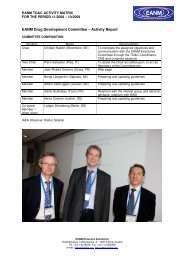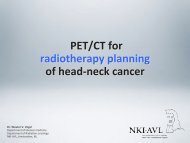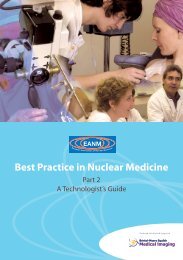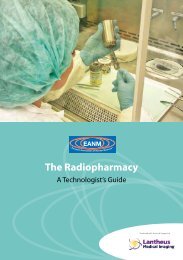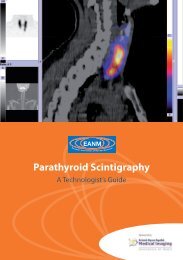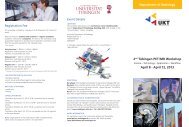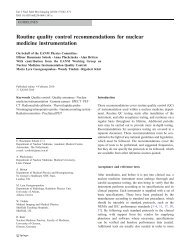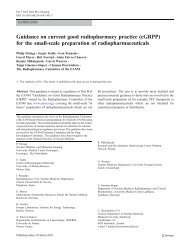EANM Basic Technologist Learning Course on PET/CT Course Aims ...
EANM Basic Technologist Learning Course on PET/CT Course Aims ...
EANM Basic Technologist Learning Course on PET/CT Course Aims ...
Create successful ePaper yourself
Turn your PDF publications into a flip-book with our unique Google optimized e-Paper software.
<str<strong>on</strong>g>EANM</str<strong>on</strong>g> <str<strong>on</strong>g>Basic</str<strong>on</strong>g> <str<strong>on</strong>g>Technologist</str<strong>on</strong>g> <str<strong>on</strong>g>Learning</str<strong>on</strong>g> <str<strong>on</strong>g>Course</str<strong>on</strong>g> <strong>on</strong> <strong>PET</strong>/<strong>CT</strong><br />
<str<strong>on</strong>g>Course</str<strong>on</strong>g> <strong>Aims</strong><br />
• To engender a basic knowledge of the physics and chemistry related to daily working<br />
practice of <strong>PET</strong>/<strong>CT</strong><br />
• To develop an understanding of how comm<strong>on</strong> <strong>PET</strong>-<strong>CT</strong> procedures are undertaken,<br />
including<br />
• specific <strong>PET</strong>-<strong>CT</strong> acquisiti<strong>on</strong> protocols<br />
• patient preparati<strong>on</strong> and patient positi<strong>on</strong>ing<br />
• radiopharmaceutical dose, administrati<strong>on</strong>, uptake<br />
• To develop an understanding of how comm<strong>on</strong>ly used <strong>PET</strong> tracers are produced (eg<br />
basic principles of operati<strong>on</strong> of a cyclotr<strong>on</strong>)<br />
• To develop a practical understanding of the radiati<strong>on</strong> protecti<strong>on</strong> issues and how<br />
measures can be taken to minimize radiati<strong>on</strong> dose to staff, patients and the general<br />
public<br />
Objectives<br />
With particular regard to the role of the <strong>PET</strong>-<strong>CT</strong> technologist, by the end of this short course<br />
participants will be able to:<br />
Saturday: Technical part<br />
08:30 – 08:35 Welcome – Introducti<strong>on</strong> of participants and instructors<br />
08:35 – 08:50 Lecture 1 (introducti<strong>on</strong>)<br />
1. Explain the roles and functi<strong>on</strong>s of the <str<strong>on</strong>g>EANM</str<strong>on</strong>g> TC and also aspects of the <str<strong>on</strong>g>EANM</str<strong>on</strong>g> as a<br />
whole<br />
2. State, in outline, the intended outcomes of this <strong>PET</strong>-<strong>CT</strong> course and the expected<br />
c<strong>on</strong>tent that should be addressed<br />
08:50 – 09:10 Lecture 2 (basics <strong>on</strong> cyclotr<strong>on</strong> principles)<br />
1. State the basic physical principles of how elements are made radioactive within a<br />
cyclotr<strong>on</strong><br />
2. State the basic principles of operati<strong>on</strong> of a cyclotr<strong>on</strong><br />
09:10 – 09:30 Lecture 3 (producti<strong>on</strong> of comm<strong>on</strong>ly used <strong>PET</strong> tracers)<br />
1. Explain, in detail, how <strong>on</strong>e comm<strong>on</strong>ly used <strong>PET</strong> radioisotope is created within a<br />
cyclotr<strong>on</strong>; state its physical characteristics too<br />
2. State other comm<strong>on</strong> examples of <strong>PET</strong> radioisotopes that can be produced within a<br />
cyclotr<strong>on</strong> and state their physical characteristics<br />
3. Explain, with the aid of diagrams, how 2-Deoxyglucose localises within a normal and<br />
diseased cell<br />
09:30 – 09:50 Lecture 4 (radiopharmacy and related quality c<strong>on</strong>trol)<br />
1. Explain the basic principles of radiopharmaceutical manufacturing<br />
2. State the comm<strong>on</strong> quality tests that could be run <strong>on</strong> radiopharmaceuticals; outline the<br />
c<strong>on</strong>sequences of poorly quality c<strong>on</strong>trolled radiopharmaceuticals<br />
<str<strong>on</strong>g>EANM</str<strong>on</strong>g> Educati<strong>on</strong>al Facility<br />
Hollandstrasse 14 / Mezzanine, 1020 Vienna, Austria<br />
Tel: +43-(0)1-212 80 30, Fax: +43-(0)1-212 80 30-9<br />
E-mail: info@eanm.org, URL: www.eanm.org<br />
Austrian Data Protecti<strong>on</strong> Act: Registrati<strong>on</strong> no. 1068431 Austrian Register of Associati<strong>on</strong>s: no. 063483520
09:50 – 10:05 Coffee Break<br />
10:05 – 11:35 Lecture 5 (physical principles of <strong>PET</strong>)<br />
1. State the mechanism by which positr<strong>on</strong> emitters decay and in relati<strong>on</strong> to this provide<br />
a basic outline of <strong>PET</strong> scanner c<strong>on</strong>structi<strong>on</strong> and operati<strong>on</strong><br />
2. State the differences in c<strong>on</strong>structi<strong>on</strong> and design between a <strong>PET</strong> scanner and a<br />
gamma camera<br />
3. With the aid of diagrams illustrate how <strong>PET</strong> image data can be acquired and also<br />
rec<strong>on</strong>structed (2 and 3D); to also include basic principles of resoluti<strong>on</strong><br />
4. Explain the following terms, in relati<strong>on</strong> to <strong>PET</strong> imaging instrumentati<strong>on</strong>:<br />
a. Resoluti<strong>on</strong><br />
b. Noise<br />
c. SUV<br />
d. Quality c<strong>on</strong>trol<br />
e. Attenuati<strong>on</strong> correcti<strong>on</strong><br />
f. Scatter correcti<strong>on</strong><br />
11:35 – 12:35 Lecture 6 (Physical principles of <strong>CT</strong>)<br />
1. State the mechanisms of operati<strong>on</strong> of a <strong>CT</strong> scanner suitable for use within a <strong>PET</strong>-<strong>CT</strong><br />
unit; including producti<strong>on</strong> of x-radiati<strong>on</strong> generally and more specifically the generati<strong>on</strong><br />
and use of x-radiati<strong>on</strong> within a <strong>CT</strong> unit<br />
2. State the parameters that can be c<strong>on</strong>trolled during <strong>CT</strong> scanner operati<strong>on</strong> to enhance<br />
image quality; in relati<strong>on</strong> to this explain how radiati<strong>on</strong> dose to the patient can be<br />
optimized (minimized) through the appropriate use of <strong>CT</strong> acquisiti<strong>on</strong> parameters<br />
3. State, in outline, how a <strong>CT</strong> scan is performed and explain the following terms<br />
a. Windowing<br />
b. Pitch<br />
c. <strong>CT</strong> (Hounsfield) number<br />
4. State comm<strong>on</strong> c<strong>on</strong>temporary applicati<strong>on</strong>s of <strong>CT</strong><br />
12:35 – 13:20 Lunch<br />
13:20 – 14:20 Lecture 7 (radiati<strong>on</strong> protecti<strong>on</strong>)<br />
With a particular emphasis <strong>on</strong> practical measures:<br />
1. With regard to the protecti<strong>on</strong> of <strong>PET</strong>-<strong>CT</strong> staff, outline the radiati<strong>on</strong> dangers that exist<br />
and also how these dangers can be minimised<br />
2. With regard to <strong>PET</strong>-<strong>CT</strong> patients, outline the radiati<strong>on</strong> dangers that exist and also how<br />
these dangers can be minimised<br />
14:30 – 17:30 Practical part: Visit of NM Department at AKH Wien<br />
19:30 Dinner: Meeting Point will be at 19:00 in the lobby of the hotel<br />
City Central<br />
<str<strong>on</strong>g>EANM</str<strong>on</strong>g> Educati<strong>on</strong>al Facility<br />
Hollandstrasse 14 / Mezzanine, 1020 Vienna, Austria<br />
Tel: +43-(0)1-212 80 30, Fax: +43-(0)1-212 80 30-9<br />
E-mail: info@eanm.org, URL: www.eanm.org<br />
Austrian Data Protecti<strong>on</strong> Act: Registrati<strong>on</strong> no. 1068431 Austrian Register of Associati<strong>on</strong>s: no. 063483520
Sunday: Clinical part<br />
09:00 – 10:15 Lecture 8 (Principles of <strong>PET</strong>-<strong>CT</strong> imaging)<br />
1. Provide basic rati<strong>on</strong>ales as to why <strong>PET</strong>-<strong>CT</strong> has particular values within clinical<br />
imaging<br />
2. State comm<strong>on</strong> pathologies that can be investigated by <strong>PET</strong>-<strong>CT</strong><br />
3. Discuss the principles of Image registrati<strong>on</strong> for a dedicated <strong>PET</strong>-<strong>CT</strong> system<br />
4. Illustrate the values and limitati<strong>on</strong>s of <strong>PET</strong>-<strong>CT</strong> and give some examples of pitfalls<br />
5. State examples of artefacts that can be created and how these can be overcome<br />
6. Explain the use of IV c<strong>on</strong>trast media and discuss the c<strong>on</strong>traindicati<strong>on</strong>s<br />
10:15 – 10:30 Coffee Break<br />
10:30 – 11:35 Lecture 9 (Patient Preparati<strong>on</strong> and Protocols of 18FDG Whole<br />
body, Cardiac and Brain <strong>PET</strong>-<strong>CT</strong>)<br />
1. Outline the mechanism of 18FDG uptake<br />
2. State the clinical indicati<strong>on</strong>s of 18FDG <strong>PET</strong>-<strong>CT</strong><br />
3. Explain, in outline, how the comm<strong>on</strong> <strong>PET</strong>-<strong>CT</strong> procedures can be c<strong>on</strong>ducted, from<br />
patient preparati<strong>on</strong> through to patient discharge.<br />
4. Explain the process of processing of the acquired data<br />
11:35 – 12:05 Lecture 10 (Applicati<strong>on</strong> of other <strong>PET</strong>-<strong>CT</strong> tracers)<br />
1. State the comm<strong>on</strong> <strong>PET</strong> radiopharmaceuticals that can be used in brain and cardiac<br />
imaging; outline their mechanisms of uptake<br />
2. For brain and cardiac, state the clinical c<strong>on</strong>diti<strong>on</strong>s that can be imaged using <strong>PET</strong>-<strong>CT</strong><br />
technology<br />
3. Explain in outline the mechanisms of uptake and indicati<strong>on</strong> of a set of “new “ <strong>PET</strong><br />
tracers like DOPA, F-MISO,FLT,F and Ga<br />
12:05 – 12:35 Case studies (Plenary)<br />
12:35 – 13:20 Lunch Break<br />
13:20 – 15:15 Practical part: Presentati<strong>on</strong> of handling computer workstati<strong>on</strong>s,<br />
processing viewing, case studies in small groups<br />
15:15 -15:45 Coffee break and evaluati<strong>on</strong> of the course<br />
<str<strong>on</strong>g>EANM</str<strong>on</strong>g> Educati<strong>on</strong>al Facility<br />
Hollandstrasse 14 / Mezzanine, 1020 Vienna, Austria<br />
Tel: +43-(0)1-212 80 30, Fax: +43-(0)1-212 80 30-9<br />
E-mail: info@eanm.org, URL: www.eanm.org<br />
Austrian Data Protecti<strong>on</strong> Act: Registrati<strong>on</strong> no. 1068431 Austrian Register of Associati<strong>on</strong>s: no. 063483520






